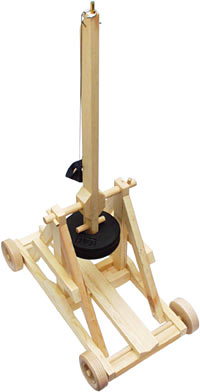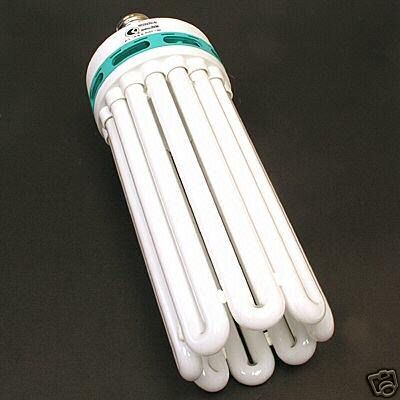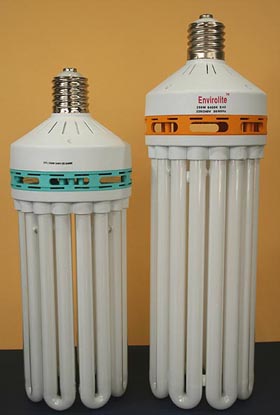Herewith, a letter I received yesterday:
As the all-knowing expert on model war machines (and the receiver of sponsorship from Backyard Artillery if I recall correctly?), I was wondering if you could recommend to me a catapult or trebuchet that is:
- Suitable for a beginner with fairly limited access to tools
- Suitable for someone who lives in a college at university (i.e. must be highly portable)
- Shippable by a method that will have it arrive by the 6th of October (the recipient's birthday)
- Not unreasonably expensive (I was thinking in the range of $80-$120, but if thats too little for something exciting, go higher)
Advice on where to get it would also be nice :)
Ed

Backyard Artillery is one of Ron Toms' numerous Web sites. He also runs Trebuchet.com and CatapultKits.com. Of his current models, I think the TK3 Model Trebuchet is the closest to the Tabletop Trebuchet I reviewed years ago. You might also like the smaller Desktop Trebuchet.
Unfortunately, though, the RLT sites don't offer international shipping any more, on account of the usual credit-card fraud BS.
(Ed didn't specifically say that he's buying a gift for someone in Australia, but I presumed he was, from his .au e-mail address. If the recipient is in the USA, by all means just go straight to trebuchet.com or catapultkits.com and pick whatever you want. And if you follow my affiliate links, I'll get a cut!)
I don't know of any companies in Australia that sell trebuchet kits (if you do, tell us all in the comments!), but fortunately, there are some dealers who'll ship Down Under.
Educational Innovations at teachersource.com, for instance. I've bought from them and I think delivery was pretty snappy; ordinary international air mail should make the cut for you, provided the package doesn't get held for examination by Customs or something (which it shouldn't, but sometimes they just do it at random to packages that don't look suspicious).
Educational Innovations resell one of Ron Toms' kits; that'd probably suit you very nicely, but it's not cheap. Eighty US bucks for the kit, plus $US47.53 for delivery to Australia. Not peanuts, and a bit over your budget, but at least you ought to get it in plenty of time. And teachersource.com have lots of other cool stuff you might like.
You might also like to consider the kits ThinkGeek sell. You want the more expensive "Trebuchet Kit", not the cheaper "Catapult" one, which commits the cardinal sin of throwing from a cup on the end of the arm rather than from a sling.
(As I mentioned in the sidebar of the old trebuchet kit review, the cup-on-the-end "catapult" is the classic image of a medieval siege engine, but it's also mechanically stupid. All proper flingers actually used a sling, which allows the projectile to be hurled much faster than the end of the arm can move.)
ThinkGeek's international shipping fees are not low, either - more than the price of the kit, in this case, though the total is still well within your budget - but the regular DHL Express International delivery option is reliable and fast enough to make the cut for you. And the shipping's not too terrible if you add a few other lightweight items to the big thing you're buying; as with teachersource.com, you can easily build a small Emergency Present Pile out of ThinkGeek gear.
(See also HobbyLink Japan, who have tons of awesome stuff, much of which is not available anything like as cheaply, or at all, outside Japan. But don't see them now, because they don't have any siege engine kits.)
At this point, I started hunting on eBay, and found a couple of sellers with apparently identical treb kits for a reasonable price. Then I found the same thing on at catapultkits.com, which told me that this kit's from Pathfinders Design and Technology in Canada. Their trebuchet is a bit spindly, but that's because it's quite a nice scale model. And it's quite cheap. And Pathfinder even seem to offer international shipping - but when I entered dummy information to see how much the shipping actually cost (I just love how many sites make you do that...), I noticed that the "Country" box on the form is a text box, which doesn't seem to actually be taken into account when you click on through.
The Pathfinders site said shipping to Australia was a lousy nine bucks, for a grand total of $CA41.22. Which is great if it's true, but I'll bet you it's not.
If you're in Canada (or, surely, the USA...), though, Pathfinders look like an excellent source for cheap treb kits. They've got several other neat-looking products, too.
If ordering directly from Pathfinders doesn't work out, here and here are the eBay sellers I found that offerend the Pathfinders kit.
If it comes to that, it's actually not very difficult to make your own trebuchet, if you don't need something that can throw a bowling ball half a mile. Lego is very good for getting the hang of the concepts, and the basic simplicity of the idea - two A-frames, axle, throwing arm with sling at one end and weight at the other - means it's also not hard to knock one together from PVC pipe, or even authentic wood.
But a pile of plumbing and a book about siege engines is, I grant you, probably not the greatest of gifts.
(UPDATE: Murray Hill of 22AD Ancient & Medieval Artillery in New Zealand commented below. He isn't quite in the treb-kit business yet; at the moment he's just sending out free plans to school students, and making catapults himself for schools, now and then. But he just told me that he plans to "come up with a student friendly machine" quite soon. Check out his Web site, particularly the Shop section, for updates!)



